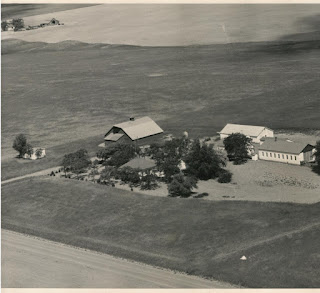Hike to the Final Mission of Flight 746
We were in the Olympic National Forest, hiking to the plane wreckage from a 1952 crash. The map directed us to a cut-off trail and then the path quickly steepened, with car-sized boulders alongside us. It was so quiet—the only sounds were birds and a creek flowing towards the Dungeness River far below.
As we hiked, I imagined what had happened to those men on that winter day.
An Air Force crew was on a rescue mission searching for survivors from a Korean airlift plane that had gone down near Sandpit, British Columbia. They were in a “flying fortress”, a WW II B-17 and as they set coordinates to return to McChord Air Force Base near Tacoma, they encountered blizzard conditions. Extreme turbulence tossed the huge plane 800 feet up and down. Their radio connection via Seattle became static.
 |
| Screenshot from Seattle PI 1952 |
Then the pilot clipped a steep ridge in the Olympic Mountains. As they crashed, the pilot was tossed out a hole in the cockpit, and part of the plane slid over the top of him. Thankfully, he lived. The cockpit then burst into flames, but the co-pilot had been thrown backwards into the bomb bay. He and other crew members careened another 2000 feet down the steep mountainside. Debris was strewn over a large area in the valley below. Three men were killed.
The survivors built emergency shelters with parachutes and bandaged their wounds. They salvaged the radio gear from the plane—but attempts to radio for help failed because they were in a deep valley. The following day, when the weather cleared enough, a helicopter crew spotted them and rescued the survivors as well as those who perished.
The crash has been called both a tragedy and a miracle—for if the plane had been 20 feet lower, it would have hit head-on into the ridge. If it had somehow cleared the first ridge it would have certainly crashed fully into the higher mountain peaks straight ahead. The heavy snowpack cushioned the fall down the jagged mountain—sparing the lives of the survivors.
The Air Force retrieved the critical components from the downed craft, but no attempt has been made to remove it from its final resting place.
Sun glistened off what appeared to be an engine housing. Further ahead we could see the surprisingly preserved landing gear. The planes interior “bomb bay” skeletal framework reminded me of how the men clung on as they slid down the mountain—with the cockpit already on fire.
The wreckage is a sobering reminder of the sacrifice made to help others in need. It was the final mission for three men. For the others it became a story of survival. They remained in the Air Force serving our nation.
I looked at the sun shining through the trees, it was a peaceful resting place for wreckage that remains a vivid testimony. Oh, America, you’ve raised many courageous and committed men and women who are willing to do what these men did.
This hike will forever remind me that being committed and courageous is still worth the effort here in America.
Air Force Flight SB-17 44-85746 crew:
Captain Casimir Hybki Jr.
Captain Kenneth Sentner
Flight Engineer Carl Scargall
Sergeant Edgar Farmer
Sergeant Charles Hartke
Radio Operator John DeRoth Died 1/19/52
Navigator Stanley Lankiewicz Jr. Died 1/19/52
Flight Engineer Alan Ball Died 1/19/52







